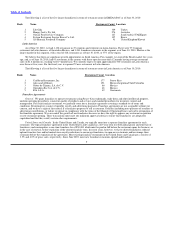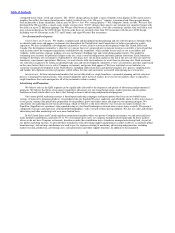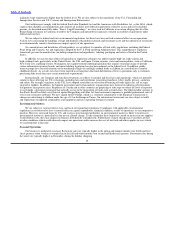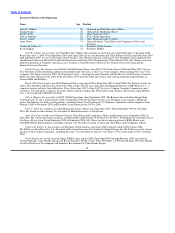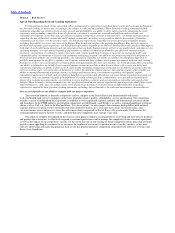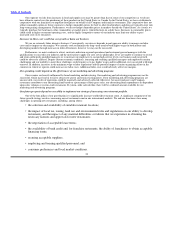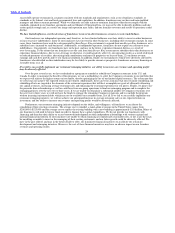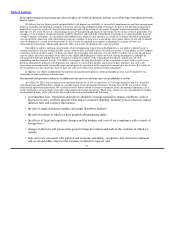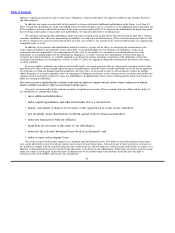Burger King 2010 Annual Report Download - page 21
Download and view the complete annual report
Please find page 21 of the 2010 Burger King annual report below. You can navigate through the pages in the report by either clicking on the pages listed below, or by using the keyword search tool below to find specific information within the annual report.
Table of Contents
Item 1A. Risk Factors
Special Note Regarding Forward−Looking Statements
Certain statements made in this report that reflect management’s expectations regarding future events and economic performance
are forward−looking in nature and, accordingly, are subject to risks and uncertainties. These forward−looking statements include
statements regarding our intent to focus on sales growth and profitability; our ability to drive sales growth by enhancing the guest
experience and expanding competitive hours of operation; our intent to expand our international platform and accelerate new
restaurant development; our beliefs and expectations regarding system−wide average restaurant sales; our beliefs and expectations
regarding the mix of franchise restaurants and Company restaurants, including our expectations that the percentage of franchise
restaurants will increase over the next few years; our beliefs and expectations regarding our newly developed restaurant designs,
including their ability to convey our vision of the Burger King brand and reinforce the message that Burger King delivers superior
products and a positive guest experience; our beliefs and expectations regarding our ability to develop innovative products that support
both ends of our barbell menu strategy and our expectation that our barbell menu strategy will grow our market share and improve our
operating margins; our expectations regarding opportunities to enhance restaurant profitability and effectively manage margin
pressures; our intention to continue to employ innovative and creative marketing strategies to increase our restaurant traffic and
comparable sales; our intention to focus on our restaurant reimaging program; our ability to use proactive portfolio management to
drive growth and optimize our restaurant portfolio; our expectation regarding our ability to continue our disciplined approach to
portfolio management in an effort to optimize our Company restaurant base, enhance development agreements with new and existing
franchisees, reduce our concentration in certain markets and opportunistically enter new markets; our belief and expectation regarding
our ability to refranchise up to half of our current Company restaurant portfolio within the next three to five years; our belief and
expectation regarding our ability to fund our U.S. and Canada restaurant reimaging program and to conclude the program within the
next two to three years, our exploration of initiatives to reduce the initial investment expense, time and uncertainty of new builds; our
ability to manage fluctuations in foreign currency exchange and interest rates; our estimates regarding our liquidity, capital
expenditures and sources of both, and our ability to fund future operations and obligations; our expectations regarding increasing net
restaurant count; our estimates regarding the fulfillment of certain volume purchase commitments; our expectations regarding the
impact of accounting pronouncements; our intention to renew hedging contracts; and our expectations regarding unrecognized tax
benefits. These forward−looking statements are only predictions based on our current expectations and projections about future events.
Important factors could cause our actual results, level of activity, performance or achievements to differ materially from those
expressed or implied by these forward−looking statements, including, but not limited to, the risks and uncertainties discussed below.
Our success depends on our ability to compete with our major competitors.
The restaurant industry is intensely competitive and we compete in the United States and internationally with many
well−established food service companies on the basis of product choice, quality, affordability, service and location. Our competitors
include a variety of independent local operators, in addition to well−capitalized regional, national and international restaurant chains
and franchises. In the FFHR industry our principal competitors are McDonald’s and Wendy’s as well as regional hamburger restaurant
chains, such as Carl’s Jr., Jack in the Box and Sonic. To a lesser extent, we also compete for consumer dining dollars with national,
regional and local (i) quick service restaurants that offer alternative menus, (ii) casual and “fast casual” restaurant chains, and
(iii) convenience stores and grocery stores that offer menu items comparable to that of Burger King restaurants. Furthermore, the
restaurant industry has few barriers to entry, and therefore new competitors may emerge at any time.
Our ability to compete will depend on the success of our plans to improve existing products, to develop and roll−out new products
and product line extensions, to effectively respond to consumer preferences and to manage the complexity of our restaurant operations
as well as the impact of our competitors’ actions. To the extent that one of our existing or future competitors offers items that are better
priced or more appealing to consumer tastes, increases the number of restaurants it operates in one of our key markets, or has more
effective advertising and marketing programs than we do, this product and price competition could adversely affect our revenues and
those of our franchisees.
19


